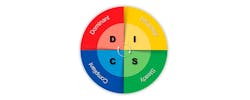Diversity, it’s a twisted term. When someone says there is no diversity, it seems most would turn their minds to cultural diversity (it is the latest rage, after all). But when it comes to diversity in your shop, it shouldn’t mean to hire certain genders or ethnic backgrounds. What it should mean is to seek out different personalities and introduce conflict. Yes, I realize that the words diversity and conflict are very scary words. You are talking about a dream you are building, and who would want someone to come in and try to change that?
Conflict is wonderful.
Conflict challenges you to be better. If you want to surround yourself with a bunch of “yes men,” then you will never explore the true potential of your dream. Dave Ramsey in his book “Entreleadership” describes this perfectly. “If two people are exactly alike, one is unnecessary.” The teams I have served were best when the group came from distinctly different mindsets (and they had the desire to bring forward their ideas).When introducing a new procedure, policy or idea into the organization, a very diverse team would come together and hash out the details. The most powerful team I have ever served on was with Pete Frey, Keith McDonald, Brian Newton, David Warren, Brandon Tullier, Doug Bell and Patrick Dillard. This fantastic group of leaders set up Take 5 for success by sitting at that table and making sure all of the details were covered. It wasn’t pretty at times; sometimes you were glad the windows didn’t open on the third floor. But after we beat up an idea, we produced the best work. It wasn’t because we agreed on the original idea, but in the end we molded it to be great. This was diversity and conflict at its best.
DISC
To better understand personalities, you need a profiling assessment. I know, I know — profiling is bad. You shouldn’t profile people based on their age, sex, race, religion, etc. But you should profile them based on their personality, because then you can figure out how to make the best out of your time with them. I encourage you all to look at the DISC profiling assessment, as this one is one of the easier systems. And like most profiling, it covers the strong traits, and you can always point out the “that’s not me.” So, treat everyone as individual people.D – Dominant
The Dominant person is possibly one of the best “fixers” you will ever come across. They may be a little straightforward, but tend to get the job done and move to the next one. They enjoy analyzing and attacking tasks. On the negative side, they can be harder to get along with, as they don’t cater to personalities as much. Also, they need to be kept busy. If you don’t give a D a new task and put them into the day-to-day, you are very likely going to have a D looking for another job or be very restless.I – Influential
The Influential is the center of attention. They love connections, flashy dressing and being wanted. They tend to have more heartfelt conversations and will work hard to pull people together. They love the customer, and the customer loves them. So, put them in sales positions, and watch the repeat customer percentage rise. The negative side of an I would be their lack of focus. Because they are caught up in the attention, they tend to over-promise and underperform. They love getting the assignments (attention), but don’t like to do them that much. If you don’t have the emotional strength to prop up an I, you are more likely to lose them.S – Steady
The Steady person is one of the most common people inside the shop. They love working with groups, and don’t like to change routines (sounds like a great tech). The S will spend a lot of the time making sure the team is happy and functioning, but unlike the I, it’s for the betterment of the team. The downside of an S is they are far less likely to make the harder decisions to move the needle if it involves crew changes. Also, they need a lot of time digesting new routines into their workflow. They will eventually come to terms with the changes if the group does.C – Compliant
The Compliant person is the critical thinker. Just like the S, they love a pattern. However, they are far more reserved than all of them. These people love numbers, charts and flow. Give them an inventory to clean up and track, and they will be in oil change heaven. They are very task-oriented and move only when they know the right move is going to be made. The downside to a C, like the S, is they don’t digest change very well. Also, they do not like the spotlight, so having them present to the group or talk to the customer would be an unfavorable outcome.There are many variations and combinations of this of course. You may be a high S with C tendencies or any other combination. Or, they may take on different attributes in public versus private. There are several online and downloadable assessments that you can take and have your crew take. Once you have this in place, you can better understand how to communicate with them and where to place them inside your structure.
Have the desire to include each of these inside your group of advisors when forming your growth culture. Understand that these are very prevalent personalities inside your team and your customers. Yes, you are the leader of your proud dream, but to build a culture that will truly fill your wallet, you will need to enlist conflict into your daily routine.
Homework
Go online, and do some research on the DISC model. Have your employees take the profile test and start making some practical applications to communication and delegation. All of this is leading up to communications, which is the next segment. Decide that you can really make a difference in your team, and then read my next few articles. Or, think your people skills are top-notch, and watch your people go to the competitors and succeed. It’s your wallet, after all. Until then, be great!About the Author

Lenny Saucier
LENNY SAUCIER has been serving the automotive aftermarket and its future leaders since 2000. He serves as director of retail training at Fullspeed Automotive. He can be reached at [email protected].
